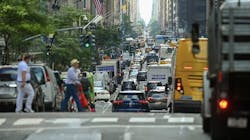New York City’s congestion pricing reducing traffic, increasing transit ridership in first six months
Congestion pricing in New York City continues to reduce traffic and raise revenue to support transit improvements across the region following the first six months of its implementation. New York Gov. Kathy Hochul and the Metropolitan Transportation Authority (MTA) say revenue generated from congestion pricing is on track to reach $500 million in 2025, allowing the MTA to advance $15 billion in critical capital improvements on its subway, bus, Long Island Rail Road (LIRR) and Metro-North Railroad (Metro-North) systems.
“Six months in, it’s clear: congestion pricing has been a huge success, making life in New York better,” Gov. Hochul said. “In New York, we dare to do big things, and this program represents just that. Traffic is down throughout the region, business is booming, transit ridership is up, and we are making historic upgrades to our transit system. We’ve also fended off five months of unlawful attempts from the federal government to unwind this successful program and will keep fighting—and winning—in the courts. The cameras are staying on.”
MTA notes it and the state continue to fight the legal challenges from the federal government to terminate the program. In May, a preliminary injunction was issued in the case of Metropolitan Transportation Authority v. Duffy, keeping congestion pricing in effect pending further court proceedings and enjoining the federal government from taking retaliatory measures in response.
"Congestion relief is a massive success and validation of the initiative keeps pouring in. The program is achieving all of its goals in terms of traffic reduction, increased travel speeds, safety, noise reduction and more,” said MTA Chair and CEO Janno Lieber. “And not only is congestion relief delivering all the projected benefits—and more—it’s also proving that New York state government can effectively execute major, ambitious initiatives that improve the quality of life in ways New Yorkers notice and appreciate.”
Activated at 12:00 a.m. on Jan. 5, 2025, the U.S.’s first urban congestion pricing program reduces gridlock in Manhattan’s Congestion Relief Zone (CRZ) below 60th Street by charging motorists to enter the zone. Since the congestion pricing program took effect on Jan. 5, MTA says it has delivered a wide array of benefits according to data from the authority and other reports and studies from business groups and other data sources.
Congestion pricing is reducing traffic and improving quality of life
In six months, MTA says congestion pricing has succeeded in reducing traffic, speeding up the flow of traffic and reducing delays throughout the region. The number of vehicles entering the zone is down by 11 percent since congestion pricing started. MTA notes that every day, 67,000 fewer vehicles enter the zone, and since the program started, more than 10 million fewer vehicles have entered the zone compared to last year.
According to a report from the Regional Plan Association and Waze, traffic delays are down in the CRZ by 25 percent and across the metropolitan region by nine percent. Delays are also down by 10 percent in the Bronx and 14 percent in parts of Bergen County, N.J. Time lost to traffic jams is down 12 percent, giving seven minutes for every hour spent in traffic in 2024 back to commuters’ lives.
Travel times on river crossings have decreased by six percent to as much as 42 percent in 2025 compared to 2024. In the Holland Tunnel, rush hour delays are down by 65 percent since congestion pricing began. In the Lincoln Tunnel, MTA says its express buses are traveling almost 24 percent faster than in 2024.
According to MTA, crashes in the CRZ are down 14 percent, and traffic injuries are down by 15 percent in the zone. The New York City Department of Transportation released data showing that pedestrian fatalities on New York City streets are at historic lows, matching levels last seen in 2018.
Transit service and ridership are on the rise
Transit ridership across all modes has increased from January through May 2025 when compared to the same period in 2024. All MTA modes of public transit have had post-pandemic record high ridership in the first half of 2025.
Ridership increases include:
- Subway ridership increase of seven percent
- Bus ridership increase of 12 percent
- LIRR ridership increase of eight percent
- Metro-North ridership increase of six percent
- Access-A-Ride ridership increase of 21 percent
MTA says transit service has steadily improved in 2025 to near record levels. In May, subway on-time performance was 85.2 percent, the best non-pandemic month in recorded history. LIRR and Metro-North on-time performance have consistently been at or near 97 percent and 98 percent respectively in 2025. Bus speeds have increased by an average of 3.2 percent within the CRZ, with some routes increasing by as much as 25 percent.
The MTA investing in transit improvements
By enabling the MTA to issue $15 billion in bonds to fund projects in its 2020-2024 Capital Plan, congestion pricing is powering improvements across the MTA network.
Improvement projects funded by congestion pricing include:
- 435 additional R211 subway cars, including 80 additional open-gangway cars.
- 44 new, more reliable dual-mode locomotives for LIRR.
- 300 new M9A cars for Metro-North and LIRR.
- Communications-based train control (CBTC) signal upgrades on the A and C lines between downtown Brooklyn and Ozone Park, allowing for more frequent and reliable service.
- Americans with Disabilities Act upgrades at 23 subway stations, including new elevators, reconstructed platforms and other improvements.
Additionally, funding from congestion pricing allows the MTA to move forward with the tunneling contract for Phase 2 of the Second Avenue Subway, which will be awarded in the second half of 2025.
